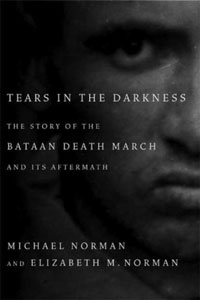 I remember reading a book about the Bataan Death March back in high school. I was astounded by the cruelty of the Japanese. But “Tears in the Darkness: The Story of the Bataan Death March and Its Aftermath,” published in 2009, takes the horror much further. The Japanese committed terrible atrocities in the Philippines, and that underscores our benevolence as conquerors in rebuilding Japan. We are good people. The Japanese, back then, were decidedly not.
I remember reading a book about the Bataan Death March back in high school. I was astounded by the cruelty of the Japanese. But “Tears in the Darkness: The Story of the Bataan Death March and Its Aftermath,” published in 2009, takes the horror much further. The Japanese committed terrible atrocities in the Philippines, and that underscores our benevolence as conquerors in rebuilding Japan. We are good people. The Japanese, back then, were decidedly not.
This book’s center is Ben Steele, a US soldier who experiences a little of everything. He fights the Japanese for three months on Bataan. He endures the death march, and then the horrific train ride to the prison camp. We see men dying constantly, and being brutalized and killed for no reason by sadistic Japanese guards. Steele survives a work detail in the far south building a road, then lands in a POW hospital in Manila. After getting well, he and hundreds of other POWs are crammed into the hold of a “hell ship” and taken to Japan as slave laborers. He’s there when Japan surrenders. The book drifts away from Steele, telling the stories of many other soldiers, but keeps coming back to him.
The subtitle is a bit misleading. The death march doesn’t start until 170 pages into the book. Up to that point, it’s all about the battle for Bataan, starting with the Jap invasion the day after Pearl Harbor. I hadn’t read much about that. Our troops, joined by Filipino troops, actually fought very well against the combat-hardened Japanese. They might have even prevailed except for some huge mistakes by General Douglas MacArthur (who doesn’t fare well in the book, at least regarding his command in the Philippines). When our troops on Bataan surrendered–76,000 Americans and Filipinos–it was the largest defeat in American history.
The authors also tell the stories of some Japanese soldiers. The whole culture of the Japanese army was based on cruelty, including to their fellow soldiers. It helped explain their casual brutality toward POWs. We see the Japanese slaughter hundreds and hundreds of Filipino prisoners, bayoneting them. But we also see Japanese soldiers who refused to take part. It reminded me of the German soldiers in “Ordinary Men” who likewise abstained from executing Jews in Poland.
I’m fascinated by how ordinary people can so easily descend into brutality. “Ordinary Men” showed that, as did “Hitler’s Willing Executioners,” “The Railway Man,” “The Rape of Nanking,” and to bring us to the present, “The Dark Side,” where America embraced torture for a short time after 9/11. (And as a fiction entry, there’s “The Lord of the Flies.”)
The mistreatment of our POWs in “Tears in the Darkness” got me so worked up that I wanted revenge. But then the authors turn a corner with the war crimes trial of the Japanese general who commanded the invasion of the Philippines (and was relieved of command shortly after we surrendered). The circumstances are far too complicated to explain here, but suffice it to say, there was a strong case for not holding him responsible for the atrocities. I’m still conflicted about it. The American military tribunal was pretty much a done deal–they went through the motions of a trial, but he was going to be killed in the end. For the authors to fling 350 pages of atrocities at the reader, and then suddenly make you sympathetic toward the Japanese general…I tell you, it was fascinating.





